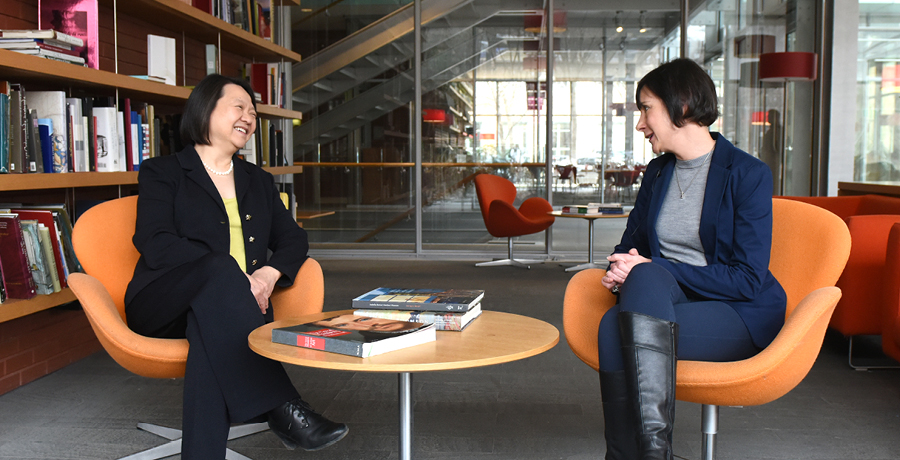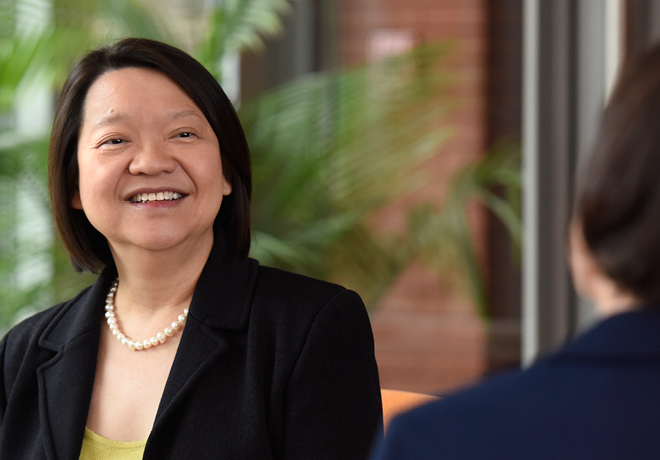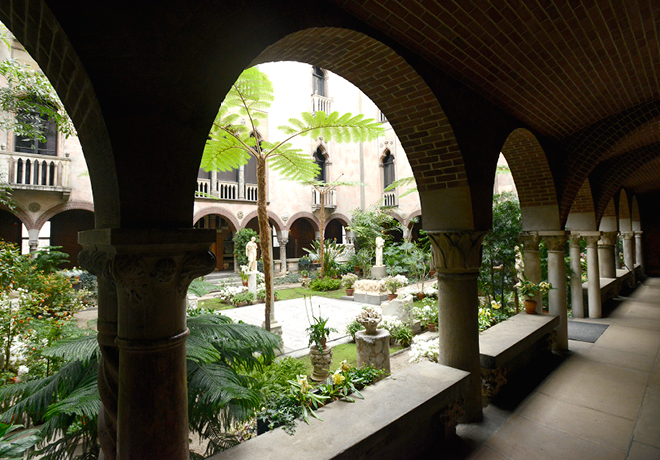
The Interview
President Eddinger discusses inclusivity and community engagement in the arts with Gardner Museum’s Peggy Fogelman

Part of an occasional series of conversations with local and national leaders about issues and trends in community college education.
As leaders of their respective institutions, BHCC President Pam Eddinger sits down with Peggy Fogelman, the Norma Jean Calderwood Director of the Isabella Stewart Gardner Museum in Boston, to explore their role in developing inclusivity and community engagement in the arts.
This interview was conducted prior to the Museum's current, temporary closure in response to COVID-19.
Pam Eddinger (PE): All of your paid internships have been with BHCC—thank you! This is a very unusual commitment. Could you share your thoughts on this?
Peggy Fogelman (PF): This is a concern we hear often in the field. To do this work, we have to reframe our thinking For the Gardner to thrive in the 21st century, it’s critical for us to build meaningful relationships with young people in Boston, and we want students to see the Gardner as a valuable resource throughout their lives.
BHCC’s commitment to local students—with 35 percent residing in the city of Boston and 84 percent within 10 miles of campus—makes this a natural partnership, and it’s been a rewarding way to build on our commitment of engaging young, local audiences with the arts.
Part of an occasional series of conversations with local and national leaders about issues and trends in community college education. As leaders of their respective institutions, BHCC President Pam Eddinger sits down with Peggy Fogelman, the Norma Jean Calderwood Director of the Isabella Stewart Gardner Museum in Boston, to explore their role in developing inclusivity and community engagement in the arts.
The Gardner Ambassador program with BHCC started in January of this year and is a paid internship program embedding students across the museum and our gallery spaces. Students spend one day a week with a staff mentor, four hours of it in the galleries with a visitor experience mentor, and a few hours each week in a seminar led by our academic programs manager, where they learn about various aspects of the Gardner, the museum field, and career pathways. The goal of the program is not only to build affinity for the arts among students, but also develop career-ready skills and comfort with museum environments. There’s also an emphasis on personal goal setting and measuring your own success, which we know are deeply held values in BHCC’s approach to education.
There’s no requirement for a particular major or background to be an Ambassador. Students may not realize how many careers and professional paths are encompassed in a museum like ours— everything from studio arts and performance to horticulture and facilities management to marketing and HR. It’s our hope that through this experience, the students may begin to consider careers in museums like the Gardner.
PE: The Gardner has recently gone through strategic planning that included identifying key elements of your mission. One of them is community engagement. Could you talk more about that value and how it aligns with the Gardner’s work?
PF: Community is our purpose and was very much a part of Isabella’s legacy during her lifetime. Most people know about Isabella’s eccentricity and artistic patronage, but fewer know how progressive and active she was in civic causes within Boston to make this a better place to live and work.
In developing the strategic plan, it was to be a renewal of Isabella’s promise that the museum be a place for ‘the education and enjoyment of the public forever.’ So quite literally, this museum exists explicitly for the enjoyment and enrichment of the people that call Boston home. That of course includes BHCC faculty, staff and students.
We also want to evolve what an art museum can be within a community. Many people know us for our incredible historical collection, but to grow and engage those we want to reach we need to think of our collection as our catalyst—an entry point for exploring current social issues, and test new models of collaboration.
We do that through a range of initiatives, including our Neighborhood Salon Luminaries program, which works closely with local artists and creative to collaborate in developing museum programs and also serves as a platform for artistic network building and sharing their own work and creative output. Luminaries and community collaborators work closely with us in developing our expanded Thursday programming, and offerings like free days held multiple times throughout the year.
The Gardner is very much a part of Boston, so we want to find as many points of engagement as possible. We learn from the community, including the students that live here, and hopefully together we make one another better.
PE: Arts institutions have sometimes been perceived as elite or out of touch with the larger community. How does the Gardner Museum address that perception and ensure it’s a place all feel welcome?
PF: Museums should be for everyone. Thankfully we’re experiencing a moment where museums and cultural institutions are examining their role within the cultural fabric with more openness and honesty, and across the country we’re seeing museums everywhere doing more to be truly representative of the people they serve.
The Gardner is no different. For all to feel welcome, all need to see themselves here and see programming and experiences they relate to. This goes back to the role community plays in being a partner to the museum and informing our exhibitions and programs. We’re also committed to ensuring broader representation of women, people of color, and non-Western artists in historical and contemporary exhibitions and performance programs.
This February we opened Boston’s Apollo: Thomas McKeller and John Singer Sargent. The exhibition, along with concurrent contemporary installations from Adam Pendleton and Lorraine O’Grady, all center on themes of race and representation, exploring Black and Brown lived experiences to expand the story of American art.
In developing Boston’s Apollo, we agreed we would need multiple voices to tell this story in an authentic and respectful way. These diverse voices included academic contributors, a network of community collaborators, and members of McKeller's family. This inclusive interpretation strategy is a new step for our museum and one that will continue to inform how we think about engaging with communities previously underserved by the museum.
And finally, we want to be top-of mind for young people looking for arts and culture experiences in Boston. This means finding ways to make our collection relevant to them, and creating new programming with an emphasis on contemporary artwork, social issues, music and performance.
We’re open late every Thursday night, so visitors can grab a drink and enjoy music in the courtyard. And we’re continuing to build our popular Third Thursday nights, which are themed evening events featuring a range of interactive activities and performances, food, drink and music.
PE: The Gardner has also expressed in its strategic plan an emphasis on connecting the past with the present at the museum. How are you doing that?
PF: As a museum with a historic collection, we have an imperative to demonstrate the continuing relevance of artworks of the past. These historic objects and works bear witness to timeless commonalities—universal human stories of love, life, spirituality, and death—and timely, complex issues in our own society. We’re always creating new opportunities to infuse our collection with contemporary relevance.
In addition to Boston’s Apollo, the recent Botticelli: Heroines + Heroes exhibition addressed issues of violence against women. Botticelli, like a modern graphic novelist, envisioned episodic stories with multiple scenes featuring the same protagonist. In that spirit, we commissioned a cartoonist to respond to Botticelli’s seminal works for the exhibition. Just as Botticelli offered a modern vision of ancient stories, the artist created up-to-date interpretations of the painter’s Renaissance masterworks. His pen and ink drawings provided frank commentary on these complex tales for the #MeToo moment.
And next winter, our upcoming Titian: Women, Myth & Power exhibition will challenge visitors to question gender and power dynamics both past and present.
It’s our job to keep this art alive, and it’s only alive if people connect with it.


Developing Citizen Artists Through a Unique Partnership
Compelled by a mutual desire to provide equity and access in the arts and encourage students to be active participants in contemporary society, a rich partnership developed between BHCC and one of Boston’s cherished cultural institutions, the Isabella Stewart Gardner Museum. Since 2016, this partnership has allowed faculty from various disciplines to use the Gardner as their extended classroom—providing opportunities for professional development and support for building curriculum.
Through the collaboration, BHCC staff, faculty, and student leaders learned the Visual Thinking Strategies (VTS) method, a rigorous discussion approach that helps students develop critical thinking and study skills through the integration of reflective practice in classrooms and workplaces. By allowing students to learn how to closely observe art, they develop the ability to apply that skill to other areas of study.
The Gardner has been teaching VTS to educators within Boston Public Schools for more than a quarter century through its “Thinking Through Art” curriculum. BHCC faculty report that students who have learned VTS are more active participants in classroom discussions and demonstrate greater synergy and respect when working within a team.

